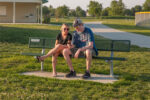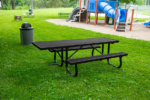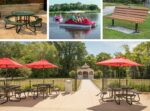No products in the cart.

Optimizing small outdoor spaces in urban environments can be a challenging task, but it also presents an opportunity to create intimate, functional areas that enhance the beauty and utility of a space. One of the best ways to achieve this is by incorporating picnic tables. This article provides valuable tips and ideas for choosing and arranging picnic tables in small outdoor areas such as patios and small parks. Our goal is to help urban planners and homeowners maximize utility and comfort in their limited spaces.
Before selecting a picnic table, it is crucial to assess the dimensions of your outdoor space. Accurate measurements are the first step in ensuring that the chosen table will fit comfortably without overcrowding the area. Identifying potential obstacles, such as trees, pathways, or existing furniture, is also important for planning the layout and traffic flow.
Consider how people will move around the space. Ensuring there is enough room to navigate around the picnic table and any attached benches is key to maintaining a functional and pleasant environment. Assessing the area thoroughly will guide your decisions and help you make the most of your small outdoor space.
Understanding how the space will be used is essential. Will it primarily serve as a dining area for alfresco meals, a social gathering spot for friends and family, or a peaceful retreat for relaxation? Estimating the number of users and how frequently the space will be used can help determine the type of picnic table that will best suit your needs.
For example, if the area will be used for frequent meals, a sturdy commercial-grade picnic table might be ideal. Alternatively, if the space is for occasional use, a smaller, portable table might suffice. Consider the specific activities that will take place and choose a table that aligns with those needs.
When space is limited, selecting the right size and shape of the picnic table is crucial. Small, compact tables are perfect for patios and small parks where space is at a premium. Popular picnic tables for small spaces include round and square designs, which offer seating for several people without taking up too much room.
Square picnic tables are particularly efficient, fitting neatly into corners or along walls. Round tables facilitate conversation and are great for social settings. Consider the shape that best fits your space and how it will be used.
The material of your picnic table will significantly impact its durability, maintenance needs, and aesthetic appeal. Here are some popular options:
Choosing the right material will depend on your specific needs and the environmental conditions of your location.
In small outdoor spaces, flexibility can be a major advantage. Portable picnic tables provide the freedom to rearrange the layout as needed, accommodating different events and seasons. These tables are easy to move and store, making them a versatile choice.
Fixed tables, on the other hand, offer greater stability and are less likely to be moved or stolen. Options like concrete picnic tables or tables with inground or surface mounts are excellent for public parks or communal areas where permanence is desired.
When arranging picnic tables in small outdoor spaces, efficient layout strategies can make a significant difference. Here are some tips to help you optimize the placement:
Carefully considering where to place your picnic tables can maximize the use of the available space. Position tables in areas that allow for easy movement around them. For instance, placing a picnic table against a wall or in a corner can free up central space, making the area feel less crowded.
In narrow spaces, aligning tables along the length can create a streamlined look and make the best use of the available area. Ensure that there’s enough space for guests to comfortably walk around the tables and access seating without obstruction.
If your outdoor space is used for multiple purposes, consider creating distinct zones. For example, one area could be designated for dining with a picnic table, while another section could have benches or lounge chairs for relaxation. This zoning approach helps to organize the space and makes it more functional.
Using different types of picnic tables in various areas can also delineate these zones. A round table can serve as a focal point for social gatherings, while a square table can be placed in a quieter corner for more intimate meals.
Comfort is a key consideration in any outdoor space. Adding shade elements such as umbrellas, pergolas, or awnings can significantly enhance the usability of your picnic tables. These features provide protection from the sun and light rain, making the space more inviting and comfortable for extended use.
For picnic tables with attached benches, choosing models that have built-in umbrella holes can simplify the addition of shade. This setup not only provides comfort but also adds a visual appeal to the space.
The seating experience can be enhanced with cushions or padded seats, particularly for picnic tables made of harder materials like concrete or steel. Adding comfortable seating options makes the space more inviting and encourages longer use.
Consider incorporating benches with backrests for additional comfort. These features can transform a simple picnic table into a cozy spot for dining, working, or socializing.
Creating an inclusive outdoor space means ensuring that everyone can comfortably use the picnic tables, including individuals with disabilities. ADA picnic tables are designed to be accessible, offering features like extended tabletops for wheelchair access. Including such tables in your layout ensures that your space is welcoming to all visitors.
In addition to ADA-compliant tables, consider other elements of inclusive design. This might include ensuring that pathways to the tables are wide and smooth enough for easy navigation by people with mobility aids.
Designing with inclusivity in mind not only meets legal standards but also fosters a sense of community and connection among all users of the space.
Maintaining your picnic tables ensures they remain functional and attractive for years to come. Different materials require different care routines:
Preparing your picnic tables for different seasons can prevent damage and extend their lifespan. In winter, consider covering or storing your tables to protect them from harsh weather. For tables that remain outdoors, using weather-resistant covers can provide added protection. During spring and summer, regular cleaning and maintenance checks will keep them in top condition for frequent use.
Investing in picnic tables for small outdoor spaces offers numerous benefits, from maximizing utility to enhancing comfort. By carefully assessing the area and determining your specific needs, you can choose the perfect picnic table that fits both your space and lifestyle. Whether opting for colorful coated metal or fiberglass, or natural wood commercial grade picnic tables, the right selection will transform your outdoor area into a functional and inviting space.
If you’re an urban planner or homeowner looking to optimize your small outdoor space, consider the benefits of adding picnic tables. At Kay Park, we offer a wide selection of picnic tables for sale, including round, square and rectangle shapes, in a variety of long lasting materials. Explore our collection to find the perfect tables that will enhance your outdoor area, providing a durable, functional, and aesthetically pleasing addition to your space.
Invest in quality picnic tables and create a welcoming environment for friends, family, and visitors to enjoy. Whether for alfresco dining, casual meetings, or simply enjoying nature, the right picnic table can make all the difference.






Kay Park Recreation
1301 Pine St.
Janesville, IA 50647
Phone: 866-741-8266
